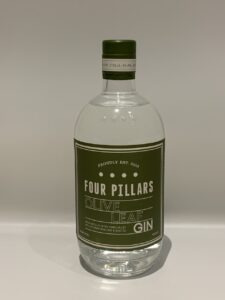 I have been excited to try this gin for a really long time. I’ve tried a number of the Four Pillars gins (notably their collab with Herno Dry Island and their Bloody Shiraz), so when I saw their Olive Leaf gin, I wanted to pop some in a martini. Sadly, they kept it exclusive to Australia for the last year before launching in Selfridges this month. In 2015, they collaborated with Santamanía Destileria Urbana in Madrid, which created their first savoury gin using fresh olives and rosemary. This became a firm favourite in the line up, and inspired them to experiment. Keeping the Mediterranean inspiration, they used three types of cold-pressed extra virgin olive oil, plus olive leaf tea, lemon, bay leaf, rosemary, lavender and grapefruit, plus Australian staples macadamia nut and lemon myrtle. It took a year of experimenting to get the right balance of flavours and textures to work in both a classic Spanish GinTonic, and the perfect martini.
I have been excited to try this gin for a really long time. I’ve tried a number of the Four Pillars gins (notably their collab with Herno Dry Island and their Bloody Shiraz), so when I saw their Olive Leaf gin, I wanted to pop some in a martini. Sadly, they kept it exclusive to Australia for the last year before launching in Selfridges this month. In 2015, they collaborated with Santamanía Destileria Urbana in Madrid, which created their first savoury gin using fresh olives and rosemary. This became a firm favourite in the line up, and inspired them to experiment. Keeping the Mediterranean inspiration, they used three types of cold-pressed extra virgin olive oil, plus olive leaf tea, lemon, bay leaf, rosemary, lavender and grapefruit, plus Australian staples macadamia nut and lemon myrtle. It took a year of experimenting to get the right balance of flavours and textures to work in both a classic Spanish GinTonic, and the perfect martini.
gin blogger
Gin Bothy Gunshot infused gin
Note: I contacted the Gin Bothy team about International Scottish Gin Day and they kindly sent me a sample to try, but as always I’ll let you know what I really think.
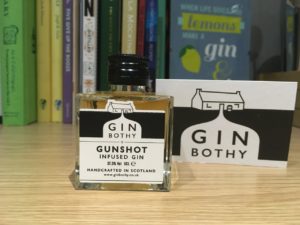 You might have seen my post about the original Gin Bothy, but today we try their Gunshot infused gin. This is proper small batch gin, they make just 38 bottles of this at a time which is distilled and infused for up to four months. They call this the “gin for whisky lovers”. Which is interesting for a country so steeped in whisky history – although the advantage being that this is rested for four months, not a minimum of three years. It opens an interesting debate around interchangeable spirits, but this is a debate that this blog doesn’t have the space for right now (or, frankly, the brain capacity or knowledge). The ‘gunshot’ they infuse their gin with is actually cinnamon, cloves and mixed spices (and it is worth noting this is bottled at 37.5% rather than the 41% of their original gin), they recommend filling your hip flask with this for a day’s hiking, or mixing it with ginger ale. I’m all about mixing gin with ginger, but how does it taste with classic tonic?
You might have seen my post about the original Gin Bothy, but today we try their Gunshot infused gin. This is proper small batch gin, they make just 38 bottles of this at a time which is distilled and infused for up to four months. They call this the “gin for whisky lovers”. Which is interesting for a country so steeped in whisky history – although the advantage being that this is rested for four months, not a minimum of three years. It opens an interesting debate around interchangeable spirits, but this is a debate that this blog doesn’t have the space for right now (or, frankly, the brain capacity or knowledge). The ‘gunshot’ they infuse their gin with is actually cinnamon, cloves and mixed spices (and it is worth noting this is bottled at 37.5% rather than the 41% of their original gin), they recommend filling your hip flask with this for a day’s hiking, or mixing it with ginger ale. I’m all about mixing gin with ginger, but how does it taste with classic tonic?
Gin Bothy Original Gin
Note: I contacted the Gin Bothy team and they sent me a sample to try, but as always I’ll let you know what I really think.
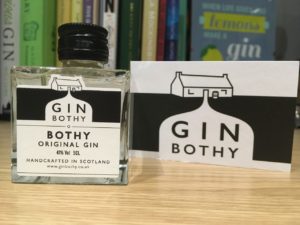 What’s a bothy you ask? The Cambridge Dictionary says “(in Scotland) a small, simple building on a hill for walkers to shelter in, or one that is used on a farm for workers to live in”. The Gin Bothy team reflect on this history and heritage and pledged to keep this at the core of their work. They use traditional methods to make their gin, using local produce such as pine needles and heather – they also have a range of fruit gins that use Scottish berries and rhubarb as botanicals. The respect for the land around them doesn’t end there, £1 from every bottle sold is donated to the Woodland Trust to regenerate the local forests that supply them with their botanicals. Starting life by infusing gin with leftover fruit jams, their range is extensive but today we try their original gin. Here is where they use their pine needles and heather alongside milk thistle, hawthorn root and rosemary which they say invokes the memory of Scottish forests. So, how does it taste?
What’s a bothy you ask? The Cambridge Dictionary says “(in Scotland) a small, simple building on a hill for walkers to shelter in, or one that is used on a farm for workers to live in”. The Gin Bothy team reflect on this history and heritage and pledged to keep this at the core of their work. They use traditional methods to make their gin, using local produce such as pine needles and heather – they also have a range of fruit gins that use Scottish berries and rhubarb as botanicals. The respect for the land around them doesn’t end there, £1 from every bottle sold is donated to the Woodland Trust to regenerate the local forests that supply them with their botanicals. Starting life by infusing gin with leftover fruit jams, their range is extensive but today we try their original gin. Here is where they use their pine needles and heather alongside milk thistle, hawthorn root and rosemary which they say invokes the memory of Scottish forests. So, how does it taste?
HYKE gin
Note: I contacted Foxhole spirits when I heard about Hyke gin and they kindly sent me a bottle to try, but as always I will let you know what I really think.
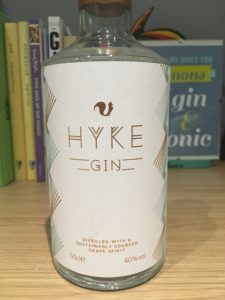 As an avid reader, I know you’ll remember my review of Foxhole gin, and Foxhole spirits have gone on to create HYKE gin. Similar to Foxhole, they use surplus grapes to create their base spirit – did you know that around 713 tonnes of grapes are not suitable for consumption so would go to waste? Once the base spirit has been made, they distil this with botanicals inspired by their grapes’ African and South American roots – juniper, coriander, aniseed, rooibos, myrrh, bay leaf and lemon zest. All in all, a slightly random mix of botanicals, but they say this creates a gin that leads with sweet citrus before spice and ‘complex aromatics’ kick in. The gin, with its beautiful labels, will be exclusively available in Tesco as part of their commitment to cut food waste by one-fifth within a decade.
As an avid reader, I know you’ll remember my review of Foxhole gin, and Foxhole spirits have gone on to create HYKE gin. Similar to Foxhole, they use surplus grapes to create their base spirit – did you know that around 713 tonnes of grapes are not suitable for consumption so would go to waste? Once the base spirit has been made, they distil this with botanicals inspired by their grapes’ African and South American roots – juniper, coriander, aniseed, rooibos, myrrh, bay leaf and lemon zest. All in all, a slightly random mix of botanicals, but they say this creates a gin that leads with sweet citrus before spice and ‘complex aromatics’ kick in. The gin, with its beautiful labels, will be exclusively available in Tesco as part of their commitment to cut food waste by one-fifth within a decade.
Brighton Gin Seaside Strength
Note: I contacted the Brighton Gin team who kindly sent me sample of their new Seaside Strength gin to try, but as always I’ll let you know what I really think.
 If you cast your mind back to 15 December 2014, you might remember I published my first ever blog post. Oh how the four years have flown. The first post was written by an inexperienced but enthusiastic gin drinker trying the new Brighton Gin which I had very excitedly reserved at a shop wayyyyyy out of my way and collected exhausted after a holiday to Stockholm. In the time it has taken for me to sort of learn what I’m doing, the Brighton Gin team have been going from strength to strength and have just added a new edition to their family – the 57% Seaside Strength gin. Made in Brighton Gin tradition, each small batch bottle is filled, waxed and labelled by hand but this gin hits you with citrus in the nose using candied orange, juniper and “notes of spice” but they don’t say what. What they do say is that this gin is smooth and perfect for drinking neat, or with tonic and lime. So, how does it taste?
If you cast your mind back to 15 December 2014, you might remember I published my first ever blog post. Oh how the four years have flown. The first post was written by an inexperienced but enthusiastic gin drinker trying the new Brighton Gin which I had very excitedly reserved at a shop wayyyyyy out of my way and collected exhausted after a holiday to Stockholm. In the time it has taken for me to sort of learn what I’m doing, the Brighton Gin team have been going from strength to strength and have just added a new edition to their family – the 57% Seaside Strength gin. Made in Brighton Gin tradition, each small batch bottle is filled, waxed and labelled by hand but this gin hits you with citrus in the nose using candied orange, juniper and “notes of spice” but they don’t say what. What they do say is that this gin is smooth and perfect for drinking neat, or with tonic and lime. So, how does it taste?
Edgerton Pink Gin
 Next up in my series of “I have lovely friends that buy me gin” is Edgerton Pink gin courtesy of my lovely friends Tasj and Martyn. You look at a pink gin and instantly think of strawberries and raspberries, but interestingly the colour for this gin comes from pomegranate extract. They combine this with a classic juniper forward gin, citrus and spiced notes because they believe that colour is strongly linked to the success of the brand. Created by Martin Edgerton Gill and inspired by his father’s love of the Pink Gin cocktail after time spent in the Royal Navy, the traditional drink is gin combined with Angostura bitters to cure seasickness. Martin took this and twisted it using his knowledge of herbal teas to create a contemporary pink gin using fifteen different botanicals – including supposed aphrodisiac damiana leaves.
Next up in my series of “I have lovely friends that buy me gin” is Edgerton Pink gin courtesy of my lovely friends Tasj and Martyn. You look at a pink gin and instantly think of strawberries and raspberries, but interestingly the colour for this gin comes from pomegranate extract. They combine this with a classic juniper forward gin, citrus and spiced notes because they believe that colour is strongly linked to the success of the brand. Created by Martin Edgerton Gill and inspired by his father’s love of the Pink Gin cocktail after time spent in the Royal Navy, the traditional drink is gin combined with Angostura bitters to cure seasickness. Martin took this and twisted it using his knowledge of herbal teas to create a contemporary pink gin using fifteen different botanicals – including supposed aphrodisiac damiana leaves.
Four Pillars Bloody Shiraz gin
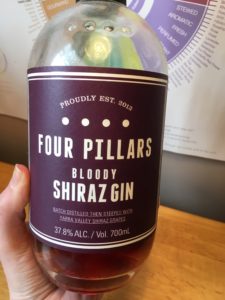 I have heard VERY good things about this gin. So when my housemate bought some of the 2017 vintage home, I was very excited. The Yarra Valley outside Melbourne, Australia, is home to a thriving wine growing community. Amongst the vineyards, you’ll find the Four Pillars distillery. They say that they base their craft distilling on four pillars – stills, water, botanicals and love. After years of research and testing, they released their Rare Dry Gin in December 2013, followed by a Barrel Aged Gin on World Gin day, 14 June 2014. On a roll, in 2014 they also released their 58.8% Navy Strength gin. Since then they have released their Bloody Shiraz gin, a spiced negroni gin, the modern Australian gin, a cardonnay barrel gin and a sherry cask gin. The Bloody Shiraz gin is closely tied to the wine industry around it, changing with each year’s vintage after the grapes are steeped in the gin for eight weeks. This gives it a rich red colour alongside notes of fresh pine, spice, and a touch of berry. Don’t confuse this with a sloe gin through – this still packs a punch at 37.8% ABV. Continue reading
I have heard VERY good things about this gin. So when my housemate bought some of the 2017 vintage home, I was very excited. The Yarra Valley outside Melbourne, Australia, is home to a thriving wine growing community. Amongst the vineyards, you’ll find the Four Pillars distillery. They say that they base their craft distilling on four pillars – stills, water, botanicals and love. After years of research and testing, they released their Rare Dry Gin in December 2013, followed by a Barrel Aged Gin on World Gin day, 14 June 2014. On a roll, in 2014 they also released their 58.8% Navy Strength gin. Since then they have released their Bloody Shiraz gin, a spiced negroni gin, the modern Australian gin, a cardonnay barrel gin and a sherry cask gin. The Bloody Shiraz gin is closely tied to the wine industry around it, changing with each year’s vintage after the grapes are steeped in the gin for eight weeks. This gives it a rich red colour alongside notes of fresh pine, spice, and a touch of berry. Don’t confuse this with a sloe gin through – this still packs a punch at 37.8% ABV. Continue reading
Gin Lane 1751
 This blog is a shout out to one of my favourite gin people – Cherry Constable. Not only is she lovely and super knowledgeable about everything, she also sends me gin in the post, yay! Today we’re talking about Gin Lane 1751, as the name suggests they take inspiration from the Victorian style of gin which favours juniper berries, liquorice and citrus. Their lineup contains four gins – a London dry, the ‘Victoria’ pink, the Old Tom and a 47% Royal Strength. Today we’re drinking the Pink and Old Tom gins. Both 40% ABV, the pink gin follows in the Navy’s footsteps by blending gin with herbal and spiced bitters – a trick that supposedly cured sea sickeness – and the Old Tom which ramps up the star anise and adds a touch of sugar with a softer, sweeter profile. Continue reading
This blog is a shout out to one of my favourite gin people – Cherry Constable. Not only is she lovely and super knowledgeable about everything, she also sends me gin in the post, yay! Today we’re talking about Gin Lane 1751, as the name suggests they take inspiration from the Victorian style of gin which favours juniper berries, liquorice and citrus. Their lineup contains four gins – a London dry, the ‘Victoria’ pink, the Old Tom and a 47% Royal Strength. Today we’re drinking the Pink and Old Tom gins. Both 40% ABV, the pink gin follows in the Navy’s footsteps by blending gin with herbal and spiced bitters – a trick that supposedly cured sea sickeness – and the Old Tom which ramps up the star anise and adds a touch of sugar with a softer, sweeter profile. Continue reading